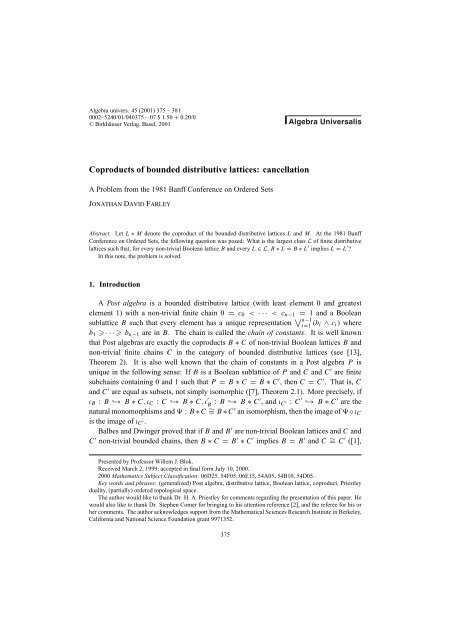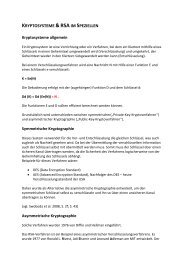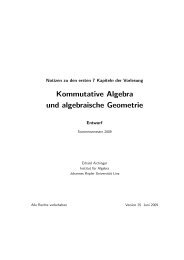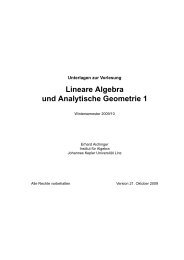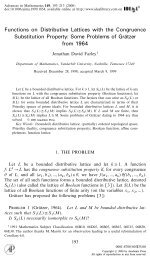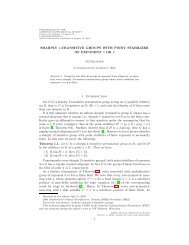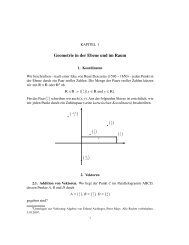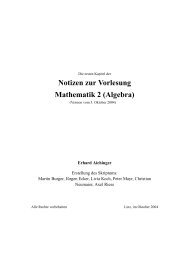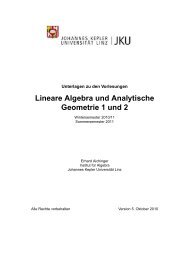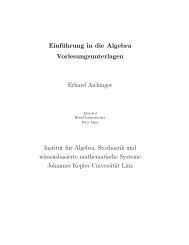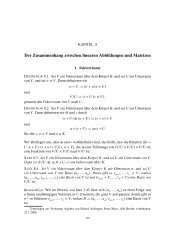Coproducts of bounded distributive lattices: cancellation
Coproducts of bounded distributive lattices: cancellation
Coproducts of bounded distributive lattices: cancellation
Create successful ePaper yourself
Turn your PDF publications into a flip-book with our unique Google optimized e-Paper software.
Algebra univers. 45 (2001) 375 – 381<br />
0002–5240/01/040375 – 07 $ 1.50 + 0.20/0<br />
© Birkhäuser Verlag, Basel, 2001<br />
<strong>Coproducts</strong> <strong>of</strong> <strong>bounded</strong> <strong>distributive</strong> <strong>lattices</strong>: <strong>cancellation</strong><br />
A Problem from the 1981 Banff Conference on Ordered Sets<br />
Jonathan David Farley<br />
Abstract. Let L ∗ M denote the coproduct <strong>of</strong> the <strong>bounded</strong> <strong>distributive</strong> <strong>lattices</strong> L and M. At the 1981 Banff<br />
Conference on Ordered Sets, the following question was posed: What is the largest class L <strong>of</strong> finite <strong>distributive</strong><br />
<strong>lattices</strong> such that, for every non-trivial Boolean lattice B and every L ∈ L,B ∗ L = B ∗ L ′ implies L = L ′ <br />
In this note, the problem is solved.<br />
1. Introduction<br />
A Post algebra is a <strong>bounded</strong> <strong>distributive</strong> lattice (with least element 0 and greatest<br />
element 1) with a non-trivial finite chain 0 = c 0 < ··· < c n−1 = 1 and a Boolean<br />
sublattice B such that every element has a unique representation ∨ n−1<br />
i=1 (b i ∧ c i ) where<br />
b 1 ··· b n−1 are in B. The chain is called the chain <strong>of</strong> constants. It is well known<br />
that Post algebras are exactly the coproducts B ∗ C <strong>of</strong> non-trivial Boolean <strong>lattices</strong> B and<br />
non-trivial finite chains C in the category <strong>of</strong> <strong>bounded</strong> <strong>distributive</strong> <strong>lattices</strong> (see [13],<br />
Theorem 2). It is also well known that the chain <strong>of</strong> constants in a Post algebra P is<br />
unique in the following sense: If B is a Boolean sublattice <strong>of</strong> P and C and C ′ are finite<br />
subchains containing 0 and 1 such that P = B ∗ C = B ∗ C ′ , then C = C ′ . That is, C<br />
and C ′ are equal as subsets, not simply isomorphic ([7], Theorem 2.1). More precisely, if<br />
ι B : B↩→ B ∗ C, ι C : C↩→ B ∗ C, ι ′ B : B↩→ B ∗ C′ , and ι C ′ : C ′ ↩→ B ∗ C ′ are the<br />
natural monomorphisms and : B ∗ C ∼ = B ∗ C ′ an isomorphism, then the image <strong>of</strong> ◦ ι C<br />
is the image <strong>of</strong> ι C ′.<br />
Balbes and Dwinger proved that if B and B ′ are non-trivial Boolean <strong>lattices</strong> and C and<br />
C ′ non-trivial <strong>bounded</strong> chains, then B ∗ C = B ′ ∗ C ′ implies B = B ′ and C ∼ = C ′ ([1],<br />
Presented by Pr<strong>of</strong>essor Willem J. Blok.<br />
Received March 2, 1999; accepted in final form July 10, 2000.<br />
2000 Mathematics Subject Classification: 06D25, 54F05, 06E15, 54A05, 54B10, 54D05.<br />
Key words and phrases: (generalized) Post algebra, <strong>distributive</strong> lattice, Boolean lattice, coproduct, Priestley<br />
duality, (partially) ordered topological space.<br />
The author would like to thank Dr. H. A. Priestley for comments regarding the presentation <strong>of</strong> this paper. He<br />
would also like to thank Dr. Stephen Comer for bringing to his attention reference [2], and the referee for his or<br />
her comments. The author acknowledges support from the Mathematical Sciences Research Institute in Berkeley,<br />
California and National Science Foundation grant 9971352.<br />
375
376 jonathan david farley algebra univers.<br />
Theorem 1). Moreover, for a given non-trivial <strong>bounded</strong> chain C, B ∗ C = B ∗ C ′ implies<br />
C = C ′ for all non- trivial Boolean <strong>lattices</strong> B and all <strong>bounded</strong> chains C ′ if and only if C is<br />
rigid, that is, has just one automorphism ([1], Theorem 6). Comer and Dwinger investigated<br />
<strong>bounded</strong> <strong>distributive</strong> <strong>lattices</strong> K such that, for all <strong>bounded</strong> <strong>distributive</strong> <strong>lattices</strong> L and M in a<br />
given class, K ∗ L = K ∗ M implies L = M ([3]).<br />
At the 1981 Banff Conference on Ordered Sets, F. Yaqub asked for a description <strong>of</strong> the<br />
largest class L <strong>of</strong> finite <strong>distributive</strong> <strong>lattices</strong> such that, for every non-trivial Boolean lattice<br />
B and every L ∈ L,B ∗ L = B ∗ L ′ implies L = L ′ ([12], p. 849).<br />
The problem as stated must be formulated more precisely, but we answer the question, as<br />
well as the corresponding one for isomorphisms (Theorems 2 and 3). Our tool is Priestley<br />
duality for <strong>distributive</strong> <strong>lattices</strong>.<br />
2. Definitions, Notation, and Basic Results<br />
For basic notions, see [6]. A poset is connected if, for all p, q ∈ P , there exist n ∈ N<br />
(which may be taken to be even) and p 1 ,...,p n ∈ P such that p = p 1 p 2 p 3 ···<br />
p n = q. Acomponent <strong>of</strong> a poset is a non-empty maximal connected subset. A subset U<br />
<strong>of</strong> a poset P is an up-set if, for all u ∈ U and p ∈ P,u p implies p ∈ U. A partially<br />
ordered topological space P is totally order-disconnected if, for all p, q ∈ P such that<br />
p̸≤ q, there exists a clopen up-set U such that p ∈ U and q/∈ U. APriestley space is a<br />
compact totally order-disconnected space.<br />
Given an ordered space P , let D(P) denote the <strong>bounded</strong> <strong>distributive</strong> lattice <strong>of</strong> clopen<br />
up-sets. Given a <strong>bounded</strong> <strong>distributive</strong> lattice L, let P (L) denote the Priestley space <strong>of</strong> prime<br />
filters, partially ordered by set-inclusion and with the topology generated by the subbasis<br />
{{F ∈ P (L) | a ∈ F } , {F ∈ P (L) | a/∈ F } | a ∈ L} .<br />
The operators D and P extend to functors which yield a dual equivalence between the categories<br />
<strong>of</strong> <strong>bounded</strong> <strong>distributive</strong> <strong>lattices</strong> with {0, 1}-preserving homomorphisms and Priestley<br />
spaces with continuous order-preserving maps. For some consequences <strong>of</strong> Priestley duality,<br />
see [9] and [10].<br />
It is well known that P (L) is an antichain if L is a Boolean lattice ([6], Theorem 9.8).<br />
Also, P (L) is a finite poset with the discrete topology if L is a finite <strong>distributive</strong> lattice.<br />
Further, P(L×M)is order-homeomorphic (order-isomorphic via a map that is a homeomorphism)<br />
to P (L) + P(M), the disjoint sum <strong>of</strong> the ordered spaces ([6], Exercise 10.3(iii)).<br />
Lastly, P(L ∗ M) is order-homeomorphic to P (L) × P(M). It can be shown that, for<br />
<strong>bounded</strong> <strong>distributive</strong> <strong>lattices</strong> L and M, L∗M is isomorphic to L P(M) , the lattice <strong>of</strong> continuous<br />
order-preserving maps from P(M)to L with the discrete topology, ordered pointwise;
Vol. 45, 2001 <strong>Coproducts</strong> <strong>of</strong> <strong>bounded</strong> <strong>distributive</strong> <strong>lattices</strong>: <strong>cancellation</strong> 377<br />
L is associated with the constant maps, and M with the maps 2 P(M) , where 2 ={0, 1}<br />
([5], Theorem and Corollary, [4], Corollary 2.3, and [11], Theorem). In [14] and [15], this<br />
aspect <strong>of</strong> duality is used to understand generalized Post algebras, coproducts <strong>of</strong> Boolean<br />
<strong>lattices</strong> and <strong>bounded</strong> <strong>distributive</strong> <strong>lattices</strong>. (See Figures 1–4.)<br />
Figure 1<br />
The poset P and the lattice L = D(P)<br />
Figure 2<br />
The poset Q and the lattice M = D(Q)<br />
Figure 3<br />
The poset P × Q
378 jonathan david farley algebra univers.<br />
Figure 4 The lattice L ∗ M ∼ = D(P × Q)<br />
3. The Solution to the Problem for Isomorphisms and Equality<br />
We must emend Yaqub’s problem because <strong>of</strong> the following example: Let B be a Boolean<br />
lattice such that B 2 ∼ = B. (For instance, let B := 2 ω .) Then for any finite poset P,B P ∼ =<br />
B (2×P) . Hence, for any non-trivial finite <strong>distributive</strong> lattice L, B ∗ L ∼ = B ∗ L 2 , where<br />
L 2 ̸∼ = L by cardinality considerations. Hence, there exist <strong>bounded</strong> <strong>distributive</strong> <strong>lattices</strong> P<br />
and L ′ such that P = B ∗L = B ∗L ′ but the image <strong>of</strong> L in P is not equal or even isomorphic<br />
to the image <strong>of</strong> L ′ in P .<br />
Therefore, in the problem, we must restrict the class to which L ′ can belong. We insist<br />
that L and L ′ belong to the same class.<br />
A class L <strong>of</strong> finite <strong>distributive</strong> <strong>lattices</strong> is shabazz if, for all <strong>lattices</strong> M and N,M×N 2 ∈ L<br />
implies M × N ∈ L. A finite <strong>distributive</strong> lattice is square-free if it has no direct factor <strong>of</strong><br />
the form N 2 (N a non-trivial lattice). Let B be the class <strong>of</strong> non-trivial Boolean <strong>lattices</strong>.<br />
LEMMA 3.1. Let X be an antichain, P and P ′ posets, C a component <strong>of</strong> P , and<br />
: X × P ∼ = X × P ′ an order-isomorphism. Let π X : X × P ′ → X be the projection.<br />
Then, for all x ∈ X, there exists x ′ ∈ X such that<br />
(π X ◦ )[{x}×C] ={x ′ }.<br />
Pro<strong>of</strong>. Suppose that (x,p 0 ) = (x ′ ,p ′ 0 ) and (x,p 1) = (x ′′ ,p ′ 1 ). If p 0 p 1 , then<br />
(x ′ ,p ′ 0 ) (x′′ ,p ′ 1 ), so that x′ = x ′′ .
Vol. 45, 2001 <strong>Coproducts</strong> <strong>of</strong> <strong>bounded</strong> <strong>distributive</strong> <strong>lattices</strong>: <strong>cancellation</strong> 379<br />
THEOREM 3.2. Let L be a shabazz class <strong>of</strong> finite <strong>distributive</strong> <strong>lattices</strong>. The following<br />
are equivalent:<br />
(1) for all B ∈ B and L, L ′ ∈ L,B ∗ L ∼ = B ∗ L ′ implies L ∼ = L ′ ;<br />
(2) every member <strong>of</strong> L is square-free.<br />
Pro<strong>of</strong>. Assume L ∼ = M × N 2 for some L ∈ L and <strong>lattices</strong> M and N (N non-trivial). Let<br />
L ′ := M × N and let B := 2 ω .AsB ∼ = B 2 ,wehaveB ∗ L ∼ = B ∗ L ′ .<br />
Now assume B ∈ B and let L and L ′ be square-free finite <strong>distributive</strong> <strong>lattices</strong>. Then<br />
B ∗ L ∼ = B ∗ L ′ implies there exists an order-isomorphism : X × P ∼ = X × P ′ where<br />
X := P(B),P := P (L), and P ′ := P(L ′ ); P and P ′ are finite posets with pairwise<br />
non-isomorphic components. Let π P ′ : X × P ′ → P ′ be the projection and fix x ∈ X. By<br />
Lemma 3.1, the map<br />
p ↦→ (π P ′ ◦ )(x, p) (p ∈ C)<br />
is an order-isomorphism on each component C <strong>of</strong> P .<br />
<br />
THEOREM 3.3. Let L be a class <strong>of</strong> finite <strong>distributive</strong> <strong>lattices</strong>.<br />
equivalent:<br />
The following are<br />
(1) for all B ∈ B and L, L ′ ∈ L,B ∗ L = B ∗ L ′ implies L = L ′ ;<br />
(2) every member <strong>of</strong> L is rigid.<br />
Pro<strong>of</strong>. Let L be a finite <strong>distributive</strong> lattice and φ : L ∼ = L a non- trivial automorphism.<br />
Define : L 2 → L 2 by (a, b) = (a, φ(b)) (a, b ∈ L). Then is an automorphism <strong>of</strong><br />
2 2 ∗ L that does not map constants to constants.<br />
Now let X be a non-empty Priestley space that is an antichain. Let P and P ′ be finite<br />
rigid posets. Let : X × P ∼ = X × P ′ be an order-homeomorphism. We must show that,<br />
for all U ∈ D(P), there exists U ′ ∈ D(P ′ ) such that [X × U] = X × U ′ .<br />
Without loss <strong>of</strong> generality, P and P ′ are connected. By Lemma 3.1, for all x ∈ X,<br />
there exists x ′ ∈ X such that [{x} ×P ] ={x ′ }×P ′ . For all x ∈ X and U ∈ D(P),<br />
let U x ′ ∈ D(P ′ ) be such that [{x} ×U] ={x ′ }×U x ′ . (Since {x} ×U is an up-set <strong>of</strong><br />
X × P,[{x} ×U] is an up-set <strong>of</strong> X × P ′ , and we already know that it is <strong>of</strong> the form<br />
{x ′ }×V for some set V ⊆ P ′ . This V must be an up-set <strong>of</strong> P ′ .)<br />
It suffices to show that, for all x 0 ,x 1 ∈ X and p ∈ P ,<br />
(π P ′ ◦ )(x 0 ,p)= (π P ′ ◦ )(x 1 ,p).<br />
By Lemma 3.1, the maps p ↦→ (π P ′ ◦ )(x 0 ,p)and p ↦→ (π P ′ ◦ )(x 1 , p)(p ∈ P) are<br />
order-isomorphisms, so, by rigidity, they are equal.
380 jonathan david farley algebra univers.<br />
COROLLARY 3.4. The largest class <strong>of</strong> finite <strong>distributive</strong> <strong>lattices</strong> with the property that,<br />
for any two <strong>lattices</strong> L, L ′ in the class and any non-trivial Boolean lattice B,<br />
B ∗ L = B ∗ L ′ implies L = L ′ ,<br />
is the class <strong>of</strong> all finite rigid <strong>distributive</strong> <strong>lattices</strong>.<br />
Hence we have solved the emended form <strong>of</strong> Yaqub’s problem, where we insist that the<br />
<strong>lattices</strong> L and L ′ belong to the same class.<br />
4. Related Results<br />
In [3], a research announcement <strong>of</strong> results that apparently were never published ∗ ,it<br />
is stated that if K,L, and M are <strong>bounded</strong> <strong>distributive</strong> <strong>lattices</strong> with L and M rigid, then<br />
K ∗ L = K ∗ M implies L = M. (The author discovered Theorem 3.3 independently <strong>of</strong><br />
[3].) The interpretation <strong>of</strong> this statement is not the same as in our paper, as is evidenced by<br />
the case where K,L, and M are each the three-element chain (cf. [8], Figure 4).<br />
In [2], Theorem 2.4(i), it is shown that there exist countable Boolean algebras L and L ′<br />
such that 2 2 ∗ L ∼ = 2 2 ∗ L ′ but L ̸∼ = L ′ . It also follows form (1.4) in [2] that, for non-trivial<br />
finite <strong>distributive</strong> <strong>lattices</strong> L, L ′ , and M,L ∗ M ∼ = L ′ ∗ M implies L ∼ = L ′ .<br />
REFERENCES<br />
[1] Balbes, R. and Dwinger, Ph., Uniqueness <strong>of</strong> representations <strong>of</strong> a <strong>distributive</strong> lattice as a free product<br />
<strong>of</strong> a Boolean algebra and a chain, Colloquium Mathematicum 24 (1971), 27–35.<br />
[2] Stephen D. Comer, Arithmetic properties <strong>of</strong> relatively free products, Proceedings <strong>of</strong> the University<br />
<strong>of</strong> Houston Lattice Theory Conference, Siemion Fajtlowicz and Klaus Kaiser (eds.), Department <strong>of</strong><br />
Mathematics, University <strong>of</strong> Houston, Houston, Texas, 1973, 180–193.<br />
[3] Stephen D. Comer and Philip Dwinger, Cancellation for <strong>bounded</strong> <strong>distributive</strong> <strong>lattices</strong>: preliminary<br />
report, Notices <strong>of</strong> the American Mathematical Society 21 (1974), A-44.<br />
[4] William H. Cornish, Ordered topological spaces and the coproduct <strong>of</strong> <strong>bounded</strong> <strong>distributive</strong> <strong>lattices</strong>,<br />
Colloquium Mathematicum 36 (1976), 27–35.<br />
[5] Brian A. Davey, Free products <strong>of</strong> <strong>bounded</strong> <strong>distributive</strong> <strong>lattices</strong>, Algebra Universalis 4 (1974), 106–107.<br />
[6] Davey, B. A. and Priestley, H. A., Introduction to Lattices and Order, Cambridge University Press,<br />
Cambridge, 1990.<br />
[7] Dwinger, Ph., Notes on Post algebras. I, Indagationes Mathematicae 28 (1966), 462–468.<br />
[8] Bjarni Jónsson, Arithmetic <strong>of</strong> ordered sets, Ordered Sets, Ivan Rival (ed.), D. Reidel, Dordrecht, Holland,<br />
1982, 3–41.<br />
[9] Priestley, H. A., Ordered topological spaces and the representation <strong>of</strong> <strong>distributive</strong> <strong>lattices</strong>, Proceedings<br />
<strong>of</strong> the London Mathematical Society 24 (1972), 507–530.<br />
[10] Priestley, H. A., Ordered sets and duality for <strong>distributive</strong> <strong>lattices</strong>, Annals <strong>of</strong> Discrete Mathematics 23<br />
(1984), North-Holland, Amsterdam, 39–60.<br />
[11] Quackenbush, R. W., Free products <strong>of</strong> <strong>bounded</strong> <strong>distributive</strong> <strong>lattices</strong>, Algebra Universalis 2 (1972),<br />
393–394.<br />
∗ The author was unsuccessful in his attempt to obtain a copy <strong>of</strong> the (unpublished) paper announced in [3].
Vol. 45, 2001 <strong>Coproducts</strong> <strong>of</strong> <strong>bounded</strong> <strong>distributive</strong> <strong>lattices</strong>: <strong>cancellation</strong> 381<br />
[12] Ivan Rival (ed.), Ordered Sets, D. Reidel, Dordrecht, Holland, 1982.<br />
[13] Rousseau, G., Post algebras and pseudo-Post algebras, Fundamenta Mathematicae 67 (1970), 133–145.<br />
[14] Speed, T. P., A note on Post algebras, Colloquium Mathematicum 24 (1971), 37–44.<br />
[15] Fawzi M. Yaqub, Representation <strong>of</strong> Post L-algebras by rings <strong>of</strong> sets, Rendiconti dell’ Istituto di Matematica<br />
dell’ Università di Trieste 14 (1982), 32–40.<br />
J. D. Farley<br />
Department <strong>of</strong> Mathematics<br />
Vanderbilt University<br />
Nashville<br />
Tennessee 37240<br />
United States <strong>of</strong> America<br />
Mathematical Sciences Research Institute<br />
1000 Centennial Drive<br />
Berkeley<br />
California 94720<br />
United States <strong>of</strong> America<br />
e-mail: farley@math.vanderbilt.edu


